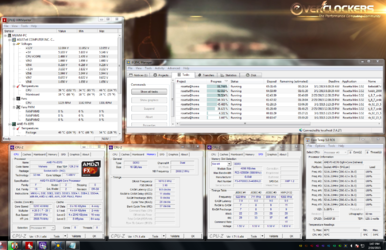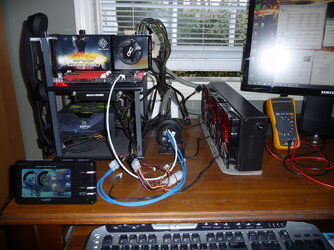- Joined
- Apr 20, 2004
- Location
- JAX, Mississauna
This one I just upped the voltage a tad and off to the races.
Indeed sounds like a cpu from the 2012 era. Hope it will go when really cold.
RGone...
Welcome to Overclockers Forums! Join us to reply in threads, receive reduced ads, and to customize your site experience!
This one I just upped the voltage a tad and off to the races.
OK for reference and a tad bit of correction and comparison info for OP.
Here's 5ghz set manually via bios. 1.525v.
My P-state info. (yours should look really close to this)
P-State FID 0x22 - VID 0x02 - IDD 18 (25.00x - 1.525 V)
P-State FID 0x1D - VID 0x02 - IDD 18 (22.50x - 1.525 V)
P-State FID 0x18 - VID 0x0B - IDD 14 (20.00x - 1.412 V)
P-State FID 0x12 - VID 0x15 - IDD 11 (17.00x - 1.287 V)
P-State FID 0x8 - VID 0x25 - IDD 7 (12.00x - 1.087 V)
P-State FID 0x10C - VID 0x35 - IDD 4 (7.00x - 0.887 V)
underlined is the one chosen to run for this screen shot.



You were asking about the "freezing" Roger. I just wondered if you have noticed the same thing? I didn't really notice it until I got to higher clocks with a heavy workload like CineR15 and high volts.
just stick the rad outside and close the window PolMy former 8370E seemed to exhibit the freeze/hang issue with much more prevalence and at lower clocks then this one. This particular sample is just an all around better clocker with a noticeably higher (~300MHz/400Mhz) ceiling.
It ran most of the day "crunching" Rosetta and I've now closed the cracked-open window... Hopefully it will continue to run okay with higher ambient temps.
The cpu socket temp has reached a peak 59C. but the average socket temps are still hovering around ~51C.
 make sure you have antifreeze if temps outside are low though.
make sure you have antifreeze if temps outside are low though.My former 8370E seemed to exhibit the freeze/hang issue with much more prevalence and at lower clocks then this one. This particular sample is just an all around better clocker with a noticeably higher (~300MHz/400Mhz) ceiling.
Looks pretty accurate, decent clock.
I can and will mention --->>
Have OCed. FX- 8320, 8350, 9590 x2 and 8300 all respectively overclocked and with really nice stability at 5200mhz.
I'd suspect cooling to be an issue to ensure any kind of stability.
Also in regards to leakage, it seems not only to be on core basis but even more so on Module basis (per 2 cores each) while lower power consumption, downing 4 cores or two of the modules seems to really help with heat, but Core #0 is and will always be most important. It runs bios. If this single core or even the module itself has high leakage, you'll be stuck at the same overclock even with a lot lower temperature at core and cpu socket.
Most of my biggest experiments was how cold effected overclocking. I did do this testing with TEC, liqquid and air. Not to mention doing runs with LN2 or Dice on several FX processors including and not limited to 4 6 and 8 core FX 81 and 83 series.
At the most extreme temps on average non cherry picked processors bought even from different regions on USA, 6500mhz to 7000mhz on DICE/LN2 cooling, bench marking was pretty average. and consistent.
So in a nut shell, 5400mhz seems to be the ceiling for any kind of "true" stability, while we may see and experience a 100mhz perhaps 200mhz difference. I don't see much more than that for any normal liquid cooling to obtain stable clocks beyond this frequency.
Simply, want a 5ghz cpu, the FX-9590 is now in a really decent price range as I've purchased a second one after killing the first HAHA.
In the end, the temps MUST be in control. Since most people have varied temps throughout the day month and year, it's hard to say that your stable clocks today will be the same tomorrow. Overclocking and stability will be a year round adventure especially for those that experience seasons like we do in Chicago.
Personally, the FX-9590 is a no brainer if you can cool the SOB. Lower temps will almost always bring lower volts.
My favorite FX processor so far to overclock as far as sheer percentages goes would be my recent FX-8300 purchase. A super cool running chip that seemed to "ceiling" at the very similar clocks as the FX-9590. Both capable of a liquid cooled max cpu-z of roughly Fifty seven hundred megahertz and stability up to about Fifty four hundred megahertz or less.
If you look for maximum percentage OC, by the lowest binned FX 8 core you can find. It'll clock about the same. If we look at a 100mhz difference, it barely changes any kind of benchmark score for an average user and certainly doesn't greatly improve gaming frame rates as the GPU handles 80% or more of graphics throughput.
My experiences above may or may not reflect that of the entire OC community, just what I've happened to notice. FX-8300 = 60 - 70% overclock with ease while FX-9590 may be more like 12 - 15% OC and both just as stable at say 5000mhz.


You'd almost think they were the same chip.
Seriously though nice write up S_B Thanks! and very consistent with what I have been seeing. Aside from the 8320 which would run fast with low volts This would be a common occurrence with All processors really. There's always one that can do this XX over the norm. but seemed to have a hard time taking them and being stableish over 5.1 and couldn't run Cinebench R15 over 5.5, so IMO the lower the leakeage I feel the sooner the CPU will top out. Here is just a matter of chilling or lack there of. One LN2 you'd get the average chips give or take 6500mhz on all 8 benching all cores. IE WPrime. CineB ect. Also out of all that I have tested it seemed to be exceptionally hard on the power system. More so than the others. Even at lower speeds with conventional cooling, I could run at 4.8 with 1.4 volts but the darn thing was on fire. Where the 9370 at the same clock take 1.476v but is much easier to control. Some just need more juices. After all your talking fast with low volts, but then a MAJOR jump after wards.

but seemed to have a hard time taking them and being stableish over 5.1 and couldn't run Cinebench R15 over 5.5, so IMO the lower the leakeage I feel the sooner the CPU will top out. Here is just a matter of chilling or lack there of. One LN2 you'd get the average chips give or take 6500mhz on all 8 benching all cores. IE WPrime. CineB ect.